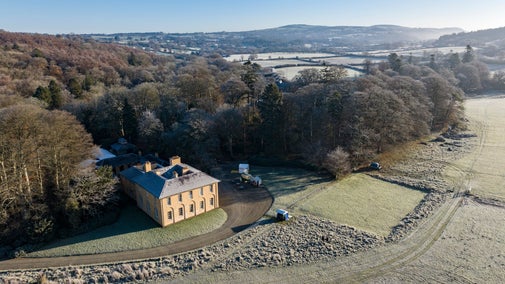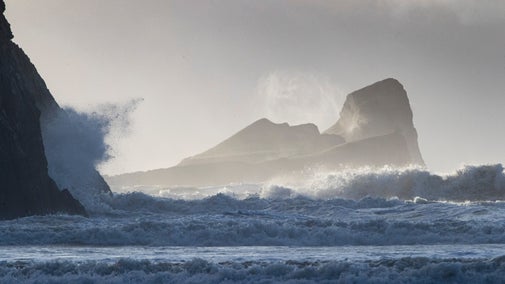
Discover more in Wales
A Celtic land with an industrial past steeped in myth, legend, poetry and song. Croeso i Gymru.

Explore the myths, legends and folklore that have shaped the ancient landscapes of Wales. From the origin of our famous Welsh red dragon in North Wales to an enchanted lake in South Wales, there’s a magical tale for everyone and a wealth of traditions to discover.
North Wales is the setting for some of our country’s most famous legends from the story of Dinas Emrys, the lofty mountain home of the dragon you see fluttering on Welsh flags to Beddgelert, the resting place of Wales’s most famous dog.

With the story of the giant, Jack O’Kent, on the Skirrid and Cwm Llwch, the enchanted lake that appeared every May day, South Wales is brimming with the mythical stories of fantastical creatures.

Learn about some of the country’s most famous traditions from the Welsh patron saint of love to the celebrations of Nos Calan Gaeaf (Winter’s Eve).
Dwynwen, the Welsh patron saint of love, was the most beautiful of King Brychan Brycheiniog’s daughters. She fell in love with a Prince called Maelon however they were unable to marry. Distraught, she begged God to help her forget him and so he sent an angel who gave her a potion to erase all memory of Maelon and turn him into a block of ice.
God then gave her three wishes. She wished that Maelon would be thawed, that she would never marry, and that the wishes and dreams of all lovers would be granted. All three wishes were fulfilled and in thanks Dwynwen devoted her life to God, setting up a convent on the island of Llanddwyn, the remains of which can be seen to this day.
Welsh people all over the world celebrate Saint David (Dewi Sant in Welsh), the patron saint of Wales on 1 March. With bright yellow daffodils, colourful traditional dress, dragon parades and rousing renditions of the national anthem, it's one of the most vibrant days in our calendar.
Born in the 6th century in Pembrokeshire, David is the only native-born saint in the UK and has many stories and miracles associated with him. Do as the Welsh at the beginning of March and pin a daffodil or leek to your lapel, cook up a Welsh feast of cawl or Welsh cakes, and join in the party at a parade or concert near you.
Calan Mai was seen as the start of summer, and after the challenges of winter it was greeted with dawnsio haf (summer dancing) and carolau mai (May carols). People would decorate the outside of their homes with hawthorn branches to symbolise growth and fertility and they’d turn their herds out to pasture for the first time.
Nos Galan Mai, or May Eve, was considered one of three ysprydnos (spirit nights) when the veil between us and the spirit world was at its thinnest. People built bonfires to protect themselves from evil spirits and carried out rituals to bring them luck for the rest of the year including leaping over the flames three times, driving cattle between fires, and putting ash in their shoes as it was thought to have magical properties.
Heuldro's Haf, or the Summer Solstice, is the first day of astronomical summer and the longest day of the year. In the traditional Welsh calendar it was welcomed with dancing, merriment and the lighting of bonfires - all celebrations that were seen as essential to producing a bountiful crop.
Midsummer eve was also known as Gathering Day because Celtic Druids believed that medicinal plants harvested on this day were especially potent. Mistletoe in particular was thought to cure all illnesses and some report that it was cut with a golden scythe and caught in a cloth before it fell to the ground. Legend has it that if a sprig collected on Midsummer Eve was placed beneath someone’s pillow, their dreams would foretell of future events.
Nos Calan Gaeaf is the Welsh for ‘Winter’s Eve’ and marks the end of harvest and the start of winter. On this night villagers would dance around a bonfire before placing stones with their name written on them into the flames. As the fire began to die they would all run home to safety believing that if they lingered their souls would be taken by the fearsome tailless black sow, Hwch Ddu Gwta, who roams the countryside with Y Ladi Wen, or the White Lady.
The following morning however, the villagers would return to the bonfire to inspect their stones. If theirs had been burned clean this was said to be good luck, however if their a stone was missing it was seen as an omen of their impending death.
With the skull of a horse, baubles for eyes, and a mane of colourful decorations, you won't forget the first time you see Mari Lwyd. On the darkest of winter evenings, often between Christmas Day and Twelfth Night, Mari and her troupe travel through Welsh villages, creating plenty of mischief as they go.
At each house they stop to request entry through a series of verses, or 'pwnco', and those inside reply with their own verses, giving an excuse for why Mari cannot enter. And so begins a battle of playful rhymes. If a homeowner relents and Mari and her group are permitted entry, they're given food and drink and the household is said to be rewarded with good luck for the year.

A Celtic land with an industrial past steeped in myth, legend, poetry and song. Croeso i Gymru.
Step into a medieval fortress with dungeons at Chirk or visit the home of the Welsh princes at Powis Castle. Discover some of the finest and most famous castles in Wales.

Explore dramatic and beautiful valleys, ancient woodlands and river walks or have an adventure through the wild Welsh mountains and visit some of the country’s most iconic peaks.

Explore magnificent Welsh mansions and their collections, from ancestral homes to buildings designed by renowned architects. Discover the history and tales from bygone days, in breath-taking settings across Wales.

Explore 157 miles of Welsh coastline protected by the National Trust, from long golden beaches to rugged clifftops.
